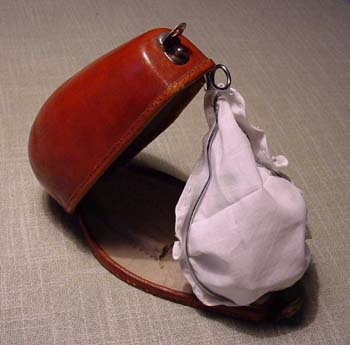 |
| Ledertasche n. ESMARCH |
"In the last quarter of 1846, it was used to provide general anesthesia for surgical operations in the USA and Great Britain. Usage spread quickly but it is not easy to administer and unpleasant to inhale. About a year later chloroform was introduced; it seemed more 'patient friendly'. However, Chloroform has been able to shut down the heart of the strongest and healthiest man ... Chloroform remained in use!
In 1877, Johann Friedrich August von Esmarch (1823-1908) published the chloroform set presented here.
"Esmarch published his chloroform anesthetic apparatus in 1877. He introduced his invention as a so-called" chloroform cutlery. "This set consisted of the described mask, a dropper bottle with chloroform and a pair of tongue pliers.The set was housed in a leather case and primarily for the It was also widely used in civilian operating theaters for decades, and in principle, the chloroform set around 1900 was all the equipment of an anesthesiologist. "
www.aerztewoche.at/viewArticleDetails.do?articleId=3204
The masks lay loosely in drawers and glass showcases in everyday clinical practice. The family doctor and the military surgeon, however, picked up the mask neatly in a sturdy leather bag that they carried with them over land: a pear-shaped leather case in which the mask, a LOMSKY dropper bottle, and a straight, flat tongue pliers could fit.
In obstetrics, the use dominated by inhalation, in dentistry, the chloroform was used rather locally:
"Of all the most recent remedies, which have an analgesic effect and are used in particular in every form of toothache, chloroform is praised, and its mode of application by evaporation and inhalation is not mentioned here, especially since this type of use is not always without danger to health and Life is and can not be done without a watching doctor, only its local use on the painful place itself, by wetting a little cotton with one or a few drops and presses on the painful tooth and gums, also rubs it neatly with the cheek , be mentioned here ".
Chloroform was inhaled from a cup that the patient held in his hollow hand, or administered via a tissue or compress that was pressed onto the patient's nose. More elegant was the use of a mask: the patient counted from 200 backwards, breathing through his mouth, 7-15 grams of chloroform were generally enough to put an adult in anesthesia.
Nota: The chloroform set was originally intended for use on the battlefields (ESMARCH specialized in this particular type of surgery). The copy presented here belonged to a completely peaceful contemporaneity: it comes from the estate of Diekircher general practitioner Paul HETTO (1895-1979), who was established in 1925.
|




